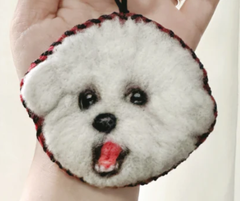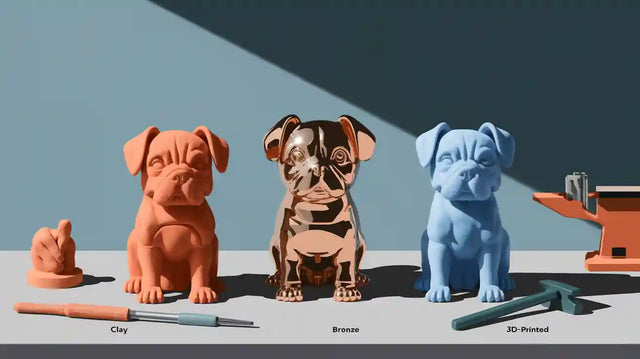Custom Pet Sculptures Material Showdown Clay Bronze or 3D Print
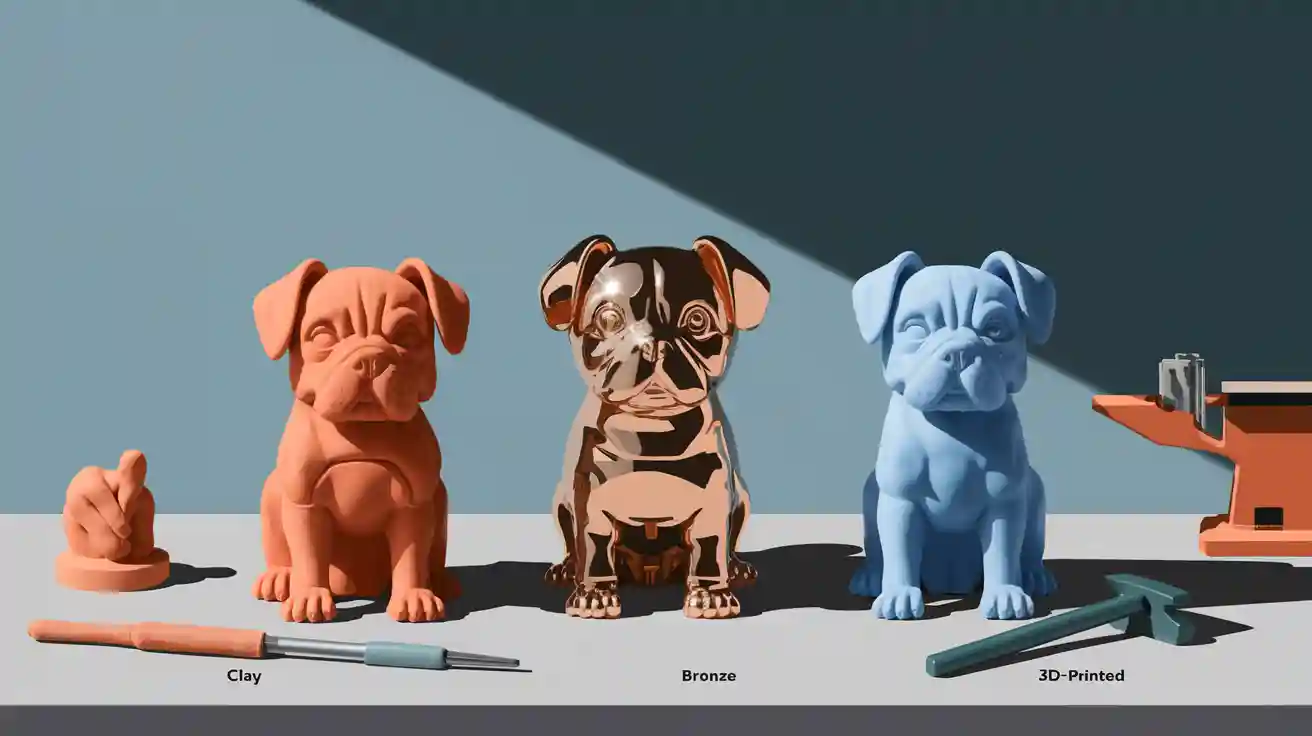
When you pick custom pet sculptures, the best material depends on what you want. Pawimprint has many years of experience making special pet keepsakes. Clay gives a classic look and feels soft. Bronze gives a strong and lasting feel. 3D print uses new technology for detailed looks. You can choose a material that fits your style, budget, and ideas. Each material has its own special features for custom pet sculptures. Think about how each material looks, feels, and how long it lasts. The material you pick helps shape the memory you keep.
Key Takeaways
Clay sculptures feel warm and handmade. They have natural textures and nice detail. You should keep them inside and handle them with care.
Bronze sculptures are strong and last a long time. They have a smooth and classic look. You can put them inside or outside.
3D printed sculptures use new technology. They are made fast and show lots of detail. They can be colorful and have many material choices. This makes them tough and easy to change.
Picking the best material depends on your budget. It also depends on how much detail you want. Think about how strong you need it to be. Also, think about how fast you want it done.
You should dust your pet sculpture often. Keep it safe from bad weather. This helps it look nice for many years, no matter what it is made of.
Types of Custom Pet Sculptures
When you want a custom pet sculpture, you can pick from three main materials: clay, bronze, and 3D printed. Each one helps you remember your pet in a different way. Pawimprint makes many kinds of custom pet sculptures. They use their skills to make keepsakes that look real and feel special.
Clay
Clay is a classic choice for custom pet sculptures. Artists use their hands to shape the clay. This helps them add small details and show what makes your pet unique. You can pick from different clays, like polymer clay or ceramic. Clay is good for both full body and bust sculptures. Many people like clay because it feels soft and looks natural. Pawimprint uses clay to make pet sculptures that feel warm and personal.
Bronze
Bronze is strong and lasts a long time. People often use bronze for fancy portrait busts and memorial statues. Artists start with a clay model and then use the lost wax method to make the bronze sculpture. Bronze gives your pet sculpture a rich color and smooth finish. It does not wear out easily and works inside or outside. Pawimprint’s bronze sculptures show lots of detail and are a classic way to remember your pet.
3D Printed
3D printed pet sculptures use new technology to make detailed figures. Artists use 3D scans or photos to design the sculpture on a computer. The 3D printer builds the sculpture layer by layer with resin or thermoplastics. 3D printed sculptures can show tiny details and come in many sizes. This material lets you get a fast and accurate copy of your pet. Pawimprint uses 3D printing for both full body and small custom pet sculptures.
Tip: You can pick from many types of custom pet sculptures, like busts, full body figures, and bobbleheads. Each material gives you a different look and feel.
Material(s) |
Common Uses/Styles |
|
|---|---|---|
Polymer Clay Figurines |
Clay |
Personalized figurines, birthday keepsakes |
Bronze Sculptures |
Bronze |
Luxury portrait busts, memorial statues |
3D Mini Figures |
Resin, Thermoplastics |
Personalized miniatures, memorial gifts |
You can choose the material that fits your ideas and needs. Every type of custom pet sculpture is a special way to remember your pet.
Appearance & Detail
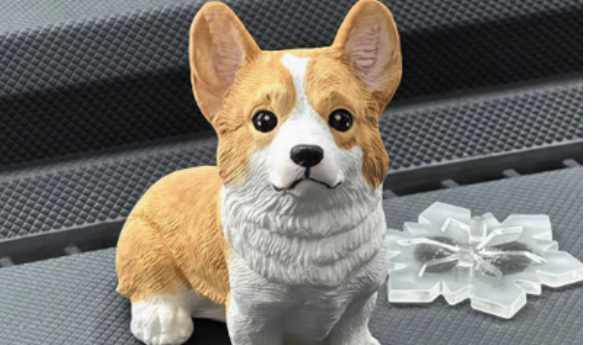
Realism
When you look for a custom pet sculpture, realism often matters most. You want your pet to look just like they do in real life. Each material brings a different level of realism to your sculpture. Bronze sculptures stand out for their lifelike features. Artists use clay models as the base, shaping every muscle and fur strand by hand. These clay models help capture your pet’s unique look before the bronze casting begins. The lost-wax method lets artists keep every detail from the clay model. You see this in life-size animal statues, where even muscle groups and fur textures look real. Zoologists have checked these details for accuracy.
Clay plays a big role in realism. Artists use clay to shape the first version of your pet. This step lets them focus on small features, like the curve of an ear or the tilt of a nose. The clay model becomes the guide for the final bronze or 3d printed sculpture.
3d technology changes how you see realism in pet sculptures. Artists use 3d scans or photos to build a digital model. This 3d model helps them capture your pet’s face, body, and pose. 3d printing lets you see a prototype before the final sculpture. You can ask for changes if you want. While 3d printed sculptures often serve as prototypes, they still show a high level of detail. The 3d process helps artists get every whisker and paw just right.
Note: Bronze sculptures, with their clay base, often show the highest realism. 3d printed models help artists perfect the design before making the final piece.
Texture & Finish
Texture and finish give your sculpture its final look and feel. Each material offers something special. Bronze sculptures have a smooth, polished surface. Artists use patinas and wax to add shine and protect the bronze. You can feel the raised fur and see the fine lines in the finish. Bronze medals use 3d laser technology to create a vibrant, raised texture. This makes the details pop and gives the sculpture a rich look.
Clay models feel soft and natural. Artists can shape the clay to show fur, wrinkles, or even a wet nose. The texture depends on the artist’s touch. Clay often serves as the first step, but some people choose to keep the clay model as their final sculpture. The finish can be matte or glossy, depending on what you like.
3d printed sculptures offer many texture options. You can pick a classic texture or a color texture. The 3d printer builds the sculpture layer by layer, so you see fine lines and tiny details. Stereolithography (SLA) 3d printing uses a laser to cure resin, making the surface smooth and detailed. You can choose a finish that matches your pet’s look. The 3d process allows for both simple and complex textures, from smooth coats to fluffy fur.
Bronze: Smooth, polished, and shiny finish. Raised details from 3d laser technology.
Clay: Soft, natural, and hand-shaped texture. Matte or glossy finish.
3d Printed: Layered, detailed, and customizable texture. Classic or color finish.
Color Choices
Color brings your pet sculpture to life. The material you choose affects your color options. Bronze sculptures usually have a classic bronze color. Artists can add patinas to change the shade, giving you choices from deep brown to greenish tones. The color stays rich and does not fade over time.
Clay gives you more color freedom. Artists can paint the clay to match your pet’s fur, eyes, and markings. You can pick bright or soft colors. The paint sticks well to the clay, so your sculpture keeps its look for years.
3d printed sculptures offer the most color choices. You can print in full color or choose a single shade. The 3d printer uses digital files to match your pet’s exact colors. You can see every spot, stripe, or patch. The 3d process lets you try different color options before printing the final sculpture. This makes it easy to get the perfect match for your pet.
Tip: If you want a sculpture that matches your pet’s real colors, 3d printed models give you the most options. Clay also works well for custom colors. Bronze offers a timeless, classic look.
Durability & Longevity
When you choose a custom pet sculpture, you want it to last. The durability and longevity of your sculpture depend on the material you pick. Clay, bronze, and 3d printed sculptures each have their own strengths. You should think about how your sculpture will handle daily life, weather, and time.
Damage Resistance
You want your sculpture to stay safe from bumps, drops, and scratches. Each material reacts differently to damage.
Bronze stands out for its toughness. This material resists dents and scratches. If you drop a bronze sculpture, it usually stays in one piece. Bronze can handle rough treatment better than most other materials. If your bronze sculpture gets damaged, you can fix it with welding and grinding. After repairs, artists re-color the surface to match the original look.
Clay feels softer and more delicate. This material can chip or crack if you drop it. You should place clay sculptures in safe spots where they will not get knocked over. Artists can repair small chips, but big breaks may need a full restoration.
3d printed sculptures offer a mix of strength and flexibility. The durability depends on the type of 3d material used. Resin 3d prints look detailed but can be brittle. Thermoplastic 3d prints bend more and resist breaking. If you want a 3d sculpture that can handle more bumps, choose a thermoplastic 3d material. You can also ask for thicker 3d walls to make your sculpture stronger.
Tip: If you want a sculpture for a busy home or a place with kids, bronze or tough 3d printed materials work best.
Indoor/Outdoor Use
Where you display your sculpture matters. Some materials work better inside, while others can handle the outdoors.
Bronze works well both indoors and outdoors. This material resists rain, sun, and wind. Bronze does not rust or fade. You can place a bronze sculpture in your garden, on your porch, or in your living room. Bronze keeps its look for many years, even in harsh weather.
Clay works best indoors. This material does not like water or big changes in temperature. If you put a clay sculpture outside, it may crack or fade. Keep clay sculptures inside to protect them.
3d printed sculptures give you many choices. Some 3d materials, like resin, work best indoors. Other 3d materials, like certain thermoplastics, can handle outdoor use. For outdoor 3d sculptures, you should pick a 3d material with UV resistance and weatherproof qualities. For example, polycarbonate 3d prints resist sunlight and temperature changes. Some 3d printed materials, like cast vinyl, offer long-term UV and fade resistance. These 3d materials can last up to 10 years outside. You can also add a protective 3d laminate layer to boost weather resistance.
Here is a table to help you compare outdoor use:
Material Type |
UV Resistance |
Weather Resistance |
Best Use Location |
|---|---|---|---|
Bronze |
Excellent |
Excellent |
Indoor/Outdoor |
Clay |
Low |
Low |
Indoor |
3d Printed Resin |
Moderate |
Low to Moderate |
Indoor |
3d Printed Thermoplastic (e.g., Polycarbonate, Vinyl) |
High |
High |
Indoor/Outdoor |
Note: If you want a sculpture for your garden or patio, bronze or certain 3d printed materials like polycarbonate or cast vinyl work best.
Care & Maintenance
Taking care of your sculpture helps it last longer. Each material needs a different care routine.
Bronze needs regular care to keep its shine. You should dust your bronze sculpture often. Every few months, you can apply a thin layer of wax to protect the surface. If your bronze sculpture has a colored finish, rewaxing helps keep the color bright. If you see any damage, you can get it fixed by a professional. They use welding, grinding, and re-coloring to restore the bronze.
Clay needs gentle cleaning. You can use a soft brush or cloth to remove dust. Do not use water or harsh cleaners. If your clay sculpture gets chipped, you can ask an artist to repair it.
3d printed sculptures are easy to care for. You can dust them with a soft cloth. For 3d prints made from resin, keep them out of direct sunlight to prevent fading. For 3d prints made from thermoplastics, you can wipe them with a damp cloth. If your 3d sculpture has a protective laminate, it will resist UV rays and moisture even better. If you see any small cracks or chips, you can ask for a 3d repair or touch-up.
Here are some simple care tips:
Place your sculpture in a safe spot away from direct sunlight and water.
Dust your sculpture often with a soft cloth or brush.
For bronze, apply wax every few months to keep the finish bright.
For 3d printed sculptures, check for any signs of fading or cracks and ask for repairs if needed.
Remember: Regular care keeps your custom pet sculpture looking beautiful for years.
You have many choices when it comes to material, 3d technology, and care. By picking the right material and following simple care steps, you can enjoy your custom pet sculpture for a long time. Whether you choose bronze, clay, or a 3d printed piece, you get a lasting memory of your beloved pet.
Cost & Value
Price Comparison
The material you choose changes the price a lot. 3D printed sculptures use new technology and cost less. You can buy a 3D printed pet bust for $42 to $75. Clay sculptures have many prices. A simple clay figure starts at $14. Bigger or more detailed clay pieces can cost up to $200. Bronze and other fancy materials cost the most. These sculptures are about $329. The higher price is because bronze and premium materials last longer and look special.
Material / Type |
Price Range (USD) |
Example Prices (USD) |
|---|---|---|
3D Printed Pet Busts |
$42 - $75 |
$42.22, $55, $75 |
Clay Sculptures |
$14 - $200 |
$14, $35, $55, $58.54, $199, $200 |
Bronze & Premium Materials |
Around $329 |
$329 (bronze, gold, copper, marble) |
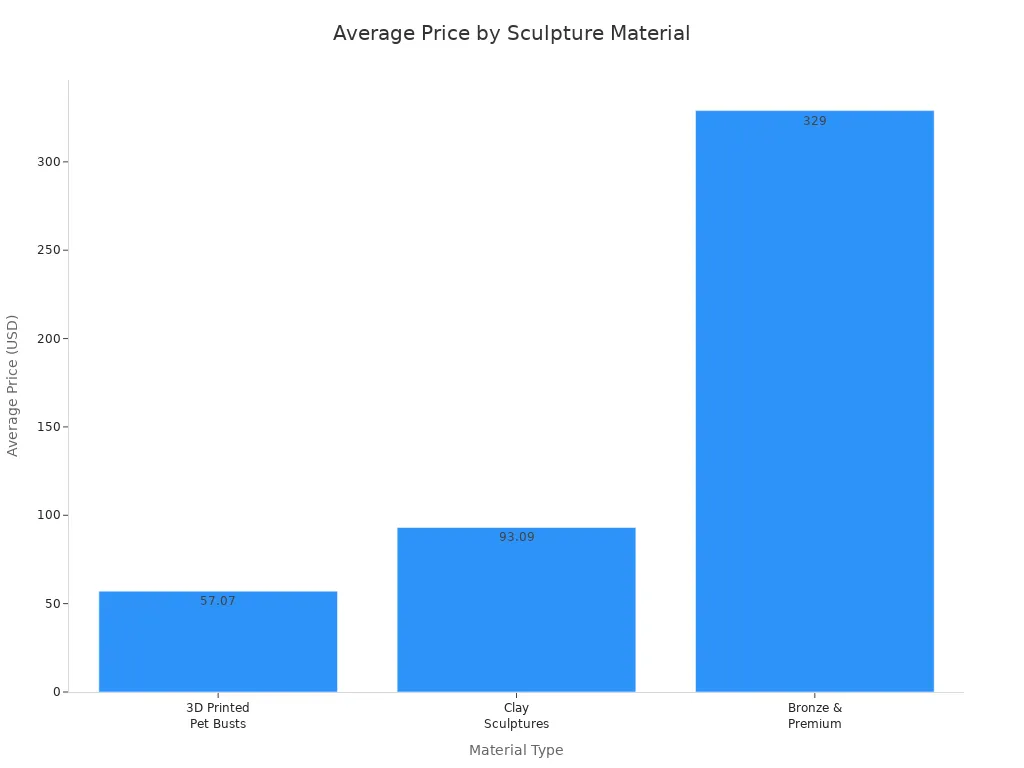
Tip: 3D printed sculptures give you good detail for a lower price.
Long-Term Value
You want your sculpture to last and stay nice. Bronze is best for long-term value. It does not rust and keeps its shine for many years. Clay looks classic and can last a long time inside if you take care of it. 3D printed sculptures use strong materials and new methods. This makes them tough and a good deal for the price. If you pick a good material, your sculpture will keep its value and memories.
What Affects Cost
Many things can change how much your sculpture costs. The main thing is the material you pick. Size matters too. Bigger sculptures need more material and work. More detail means a higher price, especially if you want it to look real. Artists with more skill may charge more, especially for rare materials or special ways of making art. Outdoor sculptures need stronger materials, which can cost extra. Digital sculpting and eco-friendly materials can also change the price.
Size of the sculpture
Detail and complexity
Artist expertise
Outdoor durability needs
Digital sculpting or eco-friendly material
Note: Talk to your artist about your budget and ideas. This helps you choose the best material and style for you.
Creation Time & Process
When you order a custom pet sculpture, how long it takes depends on the material and steps. Each way—clay, bronze, or 3d—has its own process. Pawimprint uses the best parts of each method to make your sculpture quickly and with care.
Clay Process
If you pick clay, artists shape it by hand. For a small or simple clay sculpture, you might get it in just one day. The artist sculpts, lets the clay dry, and adds details. Bigger or more detailed clay sculptures take longer. The artist spends weeks or months shaping, drying, and firing the clay. You can see the artist’s work in every part of the sculpture.
Bronze Process
Bronze sculptures take more time to finish. The artist first makes a model from clay or a 3d design. For a small bronze piece, you wait about two or three weeks. The steps are designing, making the model, casting the bronze, and finishing the surface. Large or complex bronze sculptures take much longer. It can take six months to a year to finish. The steps include design, model-making, casting, cooling, and sometimes moving or setting up the sculpture. Bronze gives you a sculpture that lasts for many years.
3D Process
The 3d process uses technology to make things faster. Artists use 3d scans or photos to create a digital model of your pet. The 3d printer builds the sculpture layer by layer. This way lets you see a preview and ask for changes before printing the final piece. The 3d process works for both small and big sculptures. Pawimprint uses 3d printing to make detailed models quickly. Sometimes, artists put 3d printed parts into clay before making a bronze sculpture. This mixes digital and traditional art skills. The 3d process needs less hand work and is more exact. You get a sculpture that looks like your pet in less time.
Here is a quick chart to compare how long each type takes:
Sculpture Type |
Size/Complexity |
Typical Creation Time (Order to Delivery) |
|---|---|---|
Clay |
Small/simple |
Can be completed within a day (few hours sculpting + drying) |
Clay |
Large/complex |
Several weeks to months (sculpting, refining, drying, firing) |
Bronze |
Small |
2 to 3 weeks (design, model-making, casting, post-processing) |
Bronze |
Large/complex |
6 months to 1 year or longer (design, model, casting, cooling, post-processing, transport, installation) |
3D Printed Pet Sculptures |
Any size |
3d printing speeds up model-making; total time varies by project |
Tip: If you want your sculpture soon, the 3d process is fastest. If you want a classic piece, bronze is worth waiting for. Clay gives you a handmade look and flexible timing.
Pawimprint uses 3d technology, skilled artists, and good materials to make beautiful pet sculptures. You get a piece that fits your time and your ideas.
Customization & Personalization
Unique Custom Pet Sculptures
You can make a special pet sculpture by picking the right material and style. Each material lets you show your pet’s personality in different ways. Clay and resin help you see small details, like fur or a special spot. Bronze gives a strong look and can be shiny or old-looking. Wood feels warm and is good for engraved words. Crystal looks modern and can have 3D pictures inside the glass. Metals like brass, pewter, or steel are good for small figures. You can choose finishes like shiny, matte, or painted to match your home.
You can pick poses, faces, and even your pet’s favorite way to stand. This makes every sculpture special and different.
Detail & Features
You can add lots of details to your sculpture with any material. Artists can shape clay and resin to show real-looking fur, eyes, and marks. Bronze lets artists carve deep and make smooth lines. Crystal and wood can have names or dates engraved on them. You can ask for things like collars, tags, or toys. Some materials, like metals and resin, can be painted or mixed with other finishes. This helps your sculpture look just like your pet.
Here is a table that shows what each material can do:
Material |
Detail Level |
Finish Options |
Accessories Possible |
|---|---|---|---|
Clay/Resin |
High |
Matte, Painted |
Yes |
Bronze |
High |
Shiny, Antique, Matte |
Yes |
Wood |
Medium |
Natural, Engraved |
Yes |
Crystal |
Medium |
Shiny, 3D Etched |
No |
Metal |
Medium |
Polished, Painted |
Yes |
Personal Touches
You can make your sculpture even more special with personal touches. Artists can add your pet’s favorite blanket, bow, or charm. You can put a name, date, or message on the base. Some materials, like wood and metal, let you engrave with a laser or by hand. You can pick the font, layout, and symbols. You can also choose a style, like real, cartoon, or artsy. Handmade work makes each piece one of a kind. You get a sculpture that feels personal and full of memories.
Tip: Adding these personal details makes your sculpture a true memory of your pet.
3D Custom Pet Sculptures
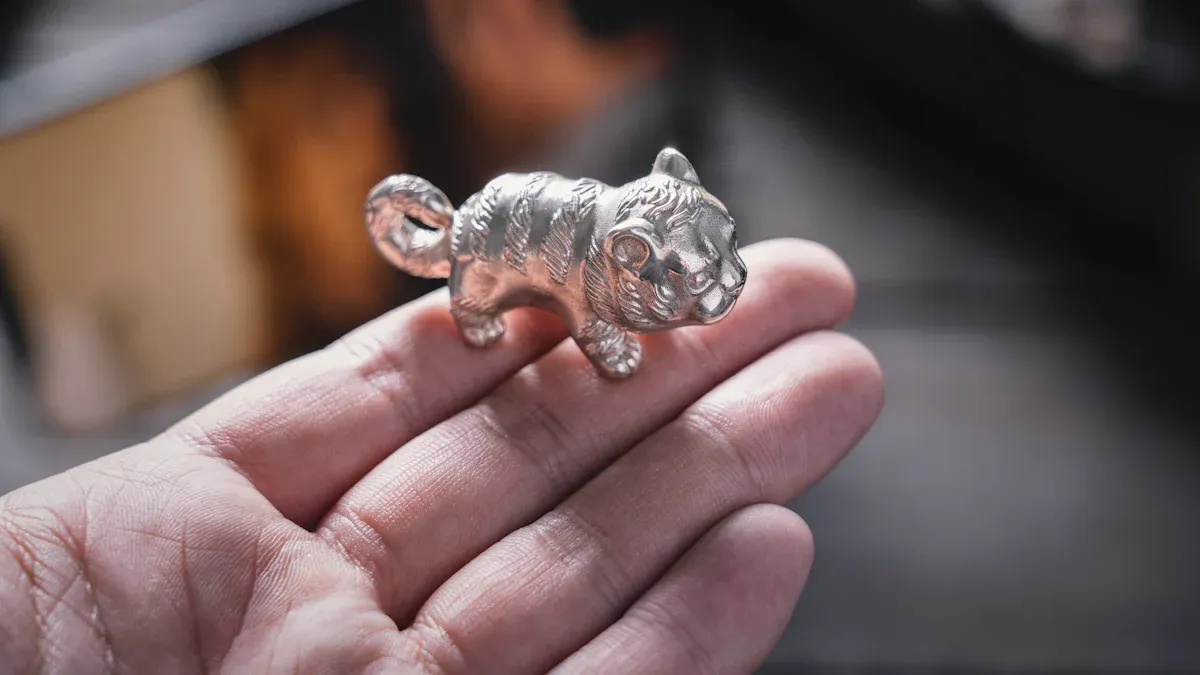
Materials Used
When you pick a 3d custom pet sculpture, you have lots of choices for material. Each 3d material changes how your sculpture will look and feel. Some 3d materials are strong, while others are soft or shiny. You can pick a 3d material that fits what you want, like more detail or more strength. Here is a table that shows the most common 3d materials and what they do for your pet sculpture:
Material |
Common Use in 3D Printed Pet Sculptures |
Key Properties |
Effect on Final Product |
|---|---|---|---|
PLA (Polylactic Acid) |
Decorative 3d pet sculptures |
Easy to print, low odor, biodegradable, minimal warping, good detail |
Gives you a smooth, detailed 3d finish for display pieces |
ABS (Acrylonitrile Butadiene Styrene) |
Durable 3d pet sculptures |
Strong, heat resistant, needs careful 3d printing |
Makes tough 3d sculptures that last longer and can handle more use |
PETG (Polyethylene Terephthalate Glycol) |
Strong and flexible 3d sculptures |
Glossy, impact resistant, flexible |
Creates shiny, flexible 3d sculptures for indoor or outdoor use |
TPU/TPE (Thermoplastic Polyurethane/Elastomer) |
Flexible 3d parts |
Soft, elastic, abrasion resistant |
Adds soft, bendable 3d features to your sculpture |
Resins (SLA/DLP) |
High-detail 3d sculptures |
High resolution, smooth surface |
Gives you very fine, smooth 3d details for premium sculptures |
You can see how each 3d material changes the look and feel of your sculpture. Some 3d materials make your sculpture shiny, while others make it soft or strong. You can talk to your artist to help pick the best 3d material for your pet’s look.
Tip: If you want a 3d sculpture with lots of tiny details, resin is a great pick. If you need a tough 3d sculpture, try ABS or PETG.
Replication & Prototyping
3d technology helps you make a copy of your pet that looks just right. You can use 3d scans or photos to make a digital 3d model of your pet. This 3d model lets you see what your sculpture will look like before it is printed. You can ask for changes to the 3d design until it looks perfect.
With 3d printing, you can make many copies of your sculpture. This is called 3d prototyping. You can try out different 3d poses, sizes, or colors. If you want to give 3d pet sculptures as gifts, you can print more from the same 3d file.
Here is how 3d replication and prototyping works:
You send a photo or scan of your pet.
The artist makes a 3d digital model.
You look at the 3d model and ask for changes.
The artist prints a 3d prototype for you to check.
When you are happy, the final 3d sculpture gets printed.
Note: 3d technology lets you see and change your sculpture before it is made. This means you get a 3d pet sculpture that matches what you want.
3d custom pet sculptures let you control every detail. You can choose the 3d material, the pose, and the finish. With 3d printing, you get a special memory of your pet that lasts.
Quick Comparison
Summary Table
It is helpful to know how clay, bronze, and 3d printed pet sculptures are different. This quick guide helps you pick the right material for your pet sculpture. Each one lets you remember your pet in a special way. The table below shows what makes each material unique.
Feature |
Clay |
Bronze |
3d Printed |
|---|---|---|---|
Appearance |
Soft, natural, hand-shaped |
Smooth, shiny, classic finish |
Detailed, layered, modern look |
Realism |
High, used for design base |
Very high, keeps fine details |
High, matches photos or scans |
Durability |
Good indoors |
Excellent, lasts 100+ years |
Varies by 3d material |
Indoor/Outdoor Use |
Best indoors |
Both indoor and outdoor |
Both, with right 3d material |
Customization |
Many options, hand-done |
Personalized, add messages |
Full 3d design, easy changes |
Creation Time |
Fast for small pieces |
Longer, uses lost wax casting |
Fast, 3d model preview available |
Cost |
Affordable to mid-range |
Higher, luxury feel |
Factory-direct, best value |
Care |
Gentle dusting |
Wax and polish |
Easy, depends on 3d material |
You can use clay to make your 3d design better before making the final sculpture. Bronze gives you a strong and classic sculpture that can last for many years. 3d printed sculptures let you see a model first, so you can ask for changes before it is made. You can also pick from different 3d materials, like resin or thermoplastics, to get what you want.
Clay models help artists show your pet’s feelings and small features. These clay models can be used as the starting point for bronze or 3d sculptures.
Bronze sculptures are made with the lost wax method. You get a sculpture that can go outside and last over 100 years.
3d printing lets you make a digital model from photos or scans. You can look at your 3d sculpture and ask for changes. 3d printing also makes it simple to order more copies for gifts.
You can add special touches to any sculpture. 3d printing gives you the most ways to change and personalize your sculpture.
If you want something fast and not too expensive, 3d printed sculptures are a good choice. If you want a classic and long-lasting sculpture, bronze is a great pick. Clay gives you a warm, handmade look and helps you improve your 3d design.
Choosing the Best Material
For Budget
You want a custom pet sculpture that fits your budget. 3d printed sculptures give you the best value. The 3d process uses less material and less time, so you pay less. Clay sculptures also offer a good price, especially for small or simple designs. Bronze costs more because the process takes longer and uses expensive materials. If you want to save money, choose a 3d printed pet sculpture. You can pick from many 3d materials, so you control the final cost.
Material |
Typical Cost |
Notes |
|---|---|---|
3d Printed |
Low |
Fast, many 3d options |
Clay |
Low-Mid |
Handmade, classic look |
Bronze |
High |
Luxury, long-lasting |
Tip: 3d printing lets you try different designs before you decide, so you avoid extra costs.
For Durability
You want your sculpture to last for years. Bronze stands out for strength and outdoor use. This metal resists weather and keeps its shine. 3d printed sculptures can also last a long time, especially if you pick a strong 3d material like ABS or PETG. Clay works well indoors but needs gentle care. If you want a sculpture for your garden or porch, bronze or a weatherproof 3d print is the best choice.
Bronze: Best for outdoor and long-term use.
3d printed (with tough 3d material): Good for both indoor and outdoor.
Clay: Best for indoor display.
For Detail
You want every whisker and spot to show. 3d printed sculptures give you very high detail, especially with fine 3d layers. Resin 3d prints show tiny features and smooth finishes. Artists use 3d scans or photos to make sure your pet looks real. Bronze also captures fine details, adding depth and a classic look. Clay gives you a soft, handmade feel with moderate detail.
Material |
Key Characteristics Relevant to Detail Level |
|---|---|
Resin 3d/Fiberglass |
Lightweight, flexible, smooth, detailed finish; ideal for intricate 3d designs |
Bronze |
Strong, rich color, adds depth to fine details |
Clay |
Moderate detail, hand-shaped |
Note: 3d printing with resin gives you the highest level of detail for custom pet sculptures.
For Speed
You may want your sculpture fast. 3d printing offers the quickest turnaround. The 3d process starts with a digital model, so you see a preview before printing. You can ask for changes to the 3d design, then print the final version in less time than other methods. Clay sculptures can be quick for small pieces, but bigger ones take longer to dry and finish. Bronze takes the most time because of the casting steps.
3d printed: Fastest, especially for small or medium 3d sculptures.
Clay: Quick for simple 3d shapes, slower for large or detailed pieces.
Bronze: Slowest, best for when you want a classic, lasting piece.
3d technology helps you get a custom pet sculpture quickly, with lots of choices for detail and finish.
You have many choices for custom pet sculptures. Clay gives you a warm, handmade feel. Bronze stands out for strength and classic style. 3d printed sculptures use new technology for fast, detailed results. Artists now blend 3d and traditional art, making designs that move from computer to real life. 3d printing saves time, keeps patterns sharp, and lets you see changes quickly. You can use 3d files to make more copies or send them anywhere. 3d tools help artists keep designs safe and easy to update. If you want the best value, 3d printed sculptures fit your budget. For outdoor use, bronze works best. For lifelike detail, 3d printing captures every feature. Pawimprint always puts care into every 3d or handmade piece. Think about what matters most to you. Reach out to Pawimprint for help choosing your perfect 3d pet sculpture.
FAQ
How do I choose the right material for my pet sculpture?
You should think about where you will display your sculpture, how much detail you want, and your budget. Clay feels warm and handmade. Bronze lasts a long time. 3D printed sculptures offer fast results and many color choices.
Can I customize the pose or add accessories to my sculpture?
Yes! You can pick your pet’s pose, facial expression, and even add favorite toys or collars. Artists work with you to make sure your sculpture matches your pet’s personality.
How do I care for my custom pet sculpture?
Dust your sculpture with a soft cloth. For bronze, use wax every few months. Keep clay and resin sculptures indoors. 3D printed pieces need gentle cleaning. Avoid harsh cleaners and direct sunlight for all materials.
How long does it take to receive my custom sculpture?
3D printed sculptures arrive fastest, sometimes in just a few days. Clay sculptures take a bit longer. Bronze sculptures need the most time because of the casting process. Ask your artist for a time estimate.
Can I order more than one copy of my pet sculpture?
Yes, especially with 3D printed sculptures. Artists can use the same digital model to make extra copies. This works well if you want to give sculptures as gifts to family or friends.
